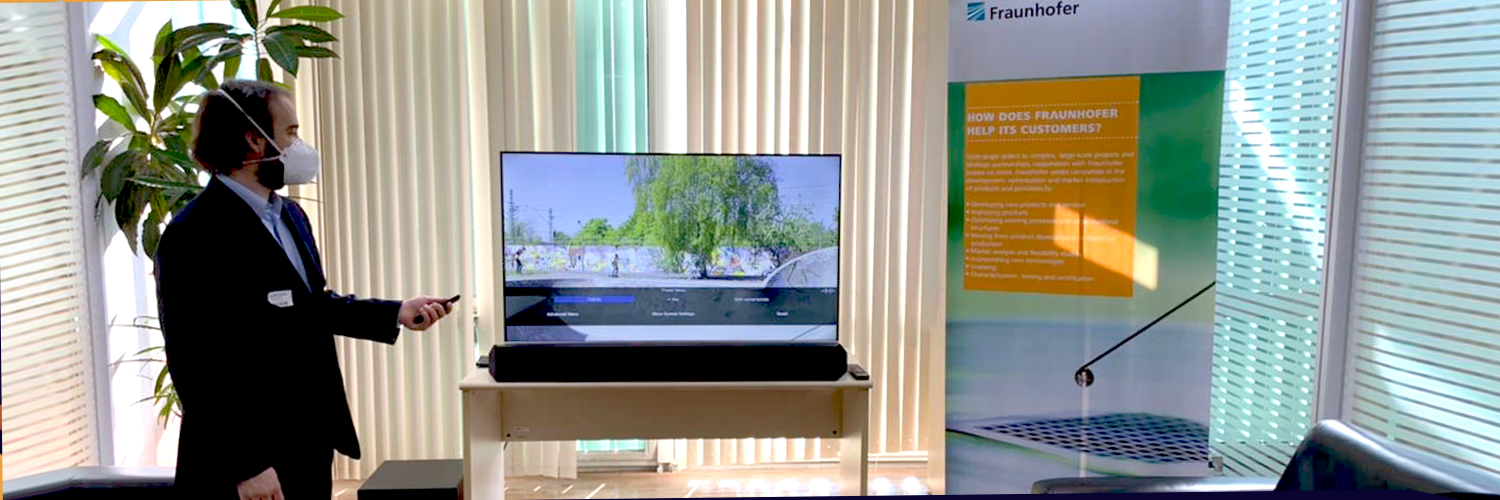Fraunhofer representatives showcase MPEG-H technology to Brazilian government officials in advance of the SBTVD Forum technology evaluation for the TV 3.0 project.
The Brazilian government is working to change the entire country’s TV infrastructure from analog to digital by December 2023. At the same time, the Brazilian Digital Terrestrial TV System Forum (SBTVD Forum) is supervising the rollout of the TV 2.5 standard, which enhances the existing broadcast infrastructure with new features, and of the TV 3.0 project, which tests and evaluates new technologies for the next-generation broadcast system.
MPEG-H has already been included in the TV 2.5 SBTVD broadcast specifications for enhanced audio experiences over ISDB-Tb. It is also the most advanced audio system proposed in answer to the TV 3.0 call for proposals. That’s why Fraunhofer IIS was invited to present the technology to government officials and industry experts during the “National Week of Communications” held by the Brazilian Ministry of Communications in early May 2021. During the week-long event, the next steps of the modernization project were discussed and Minister of Communications Fábio Faria signed the plans for the next stages of the technology evaluation carried out with the SBTVD Forum.
Several universities throughout the country will take a closer look at the suitability of some technologies, including MPEG-H, that have already been tested in large-scale broadcasts. Together with major industry partners, Fraunhofer IIS will provide the SBTVD Forum with a complete end-to-end broadcast system to enable the evaluation of all MPEG-H Audio features in the most challenging live broadcast scenarios.
The Brazilian Ministry of Communications is looking for a range of features in the audio technology set to become the broadcasting standard for the decades ahead. These include realistic immersive sound that can be reproduced on several device types, ease of use, and a high degree of interactivity, customizability and accessibility. According to an official statement released by the Brazilian Ministry of Communications, Broadcasting Secretary Otávio Caixeta stressed the role of customizable audio technology for accessibility, as the wide availability of audio description and its customizable position in the room as well as the personalized balance of dialogue and background sounds will enable many people with visual or hearing impairments to access the broadcasting program.
The team representing Fraunhofer IIS in Brazil was excited to show that MPEG-H delivers on all specifications. They were also pleased to have a chance to demonstrate that MPEG-H Audio can ensure a smooth transition from TV 2.5 to TV 3.0 and also deliver the most advanced personalization and accessibility options for the audience. Colleagues and partners from São Paulo, Rio de Janeiro, Brasília and Erlangen worked hard to plan the event and to deliver content and devices to the ministry. This complex task was made even more challenging by the restrictions imposed by the COVID-19 pandemic. Thanks to the united efforts, the demonstrations could go ahead as planned and were attended by several participants in senior roles.
“We are very happy that the Ministry of Communications and the SBTVD Forum have invited us to demonstrate the scope and quality of MPEG-H personalized and immersive sound. We believe that we were able to provide a very good impression of the technology’s capabilities and strengthen its position for the further integration into the Brazilian broadcast environment,” says Adrian Murtaza, Senior Technology and Standards Manager at Fraunhofer IIS.
More information is available from the Brazilian Ministry of Communications (in Portuguese): https://www.gov.br/mcom/pt-br/noticias/2021/maio/do-cinema-para-casa-tecnologia-de-som-tridimensional-aperfeicoa-experiencia-audiovisual-no-pais
Header image: © Fraunhofer IIS
This post is also available in: Deutsch

